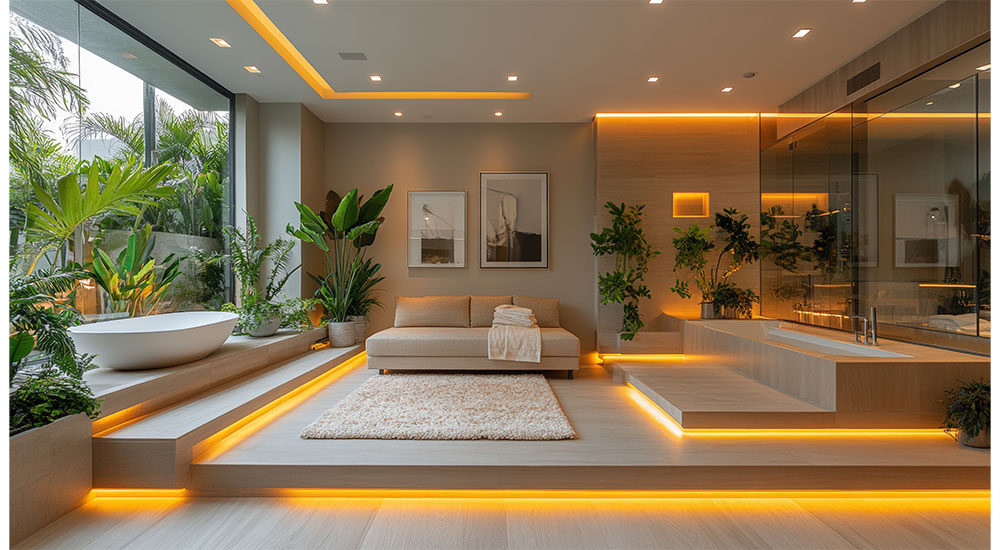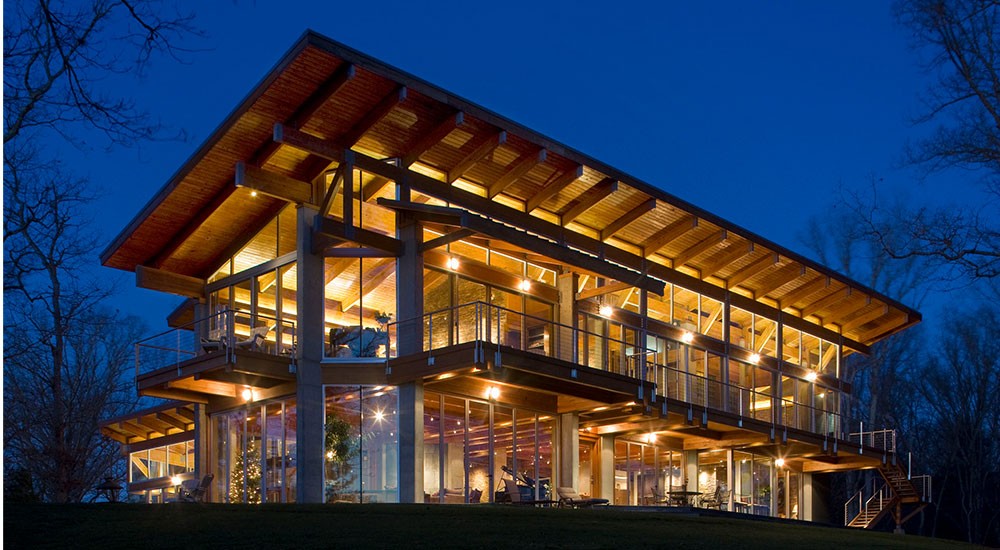Over the past five years, lighting has emerged as one of the most pivotal design elements in modern interiors, often equaling other aspects of home design in terms of importance. Most clients might have been solely preoccupied with updating their appliances, countertops or furniture. Today, designers and their clients recognize lighting as a key factor in making a space feel more comfortable and functional, especially when it comes to creating areas that suit various activities, from cooking and working to relaxing and entertaining.
Above photo: A whole-house lighting design/build project near Asheville, N.C., by Arche Lighting Group
The Evolution of Lighting Design
Interior designers are constantly seeking new ways to set themselves apart in a competitive industry, and lighting has emerged as a prime tool for expanding their offerings. What was once seen as a potential afterthought has now evolved into a central focus in residential design. Good lighting does much more than illuminate a space – it accents and elevates the interior design, enhancing the furniture, artwork and architectural elements. A true and thoughtfully planned lighting design does not just allow you to see; it creates a feeling in a space you want to be in.
Once homeowners experience the transformative power of lighting in their spaces, they truly begin to appreciate its value. Lighting is now seen as integral to the interior design process, with architects and designers using it to enhance their artistic vision and create specific moods within a room.
Lighting: An Essential Layer of Design
Interior designers carefully select furnishings, textures and finishes to match the desired look and feel of a home, and lighting should be considered just as carefully. Good lighting is not just about getting light into a room; it’s about using light to enhance the space. This concept has become widely understood by designers and architects, many of whom partner with lighting designers to ensure the best outcome for their clients. The goal is always to ensure that the room functions well while also creating the desired ambiance, whether it’s bright and energizing or soft and relaxing.

Photo credit: Dreamy Shots/stock.adobe.com
Lighting in the Home: A Layered Approach
Lighting is about more than just general illumination – it should be customized based on how a space is used. A well-designed lighting plan incorporates different layers of light, including ambient, task and accent lighting, to create a functional and visually pleasing environment. For example, in the kitchen, task lighting might be placed over countertops or under cabinets for cooking and preparation, while ambient lighting provides overall room illumination. This layered approach is essential for creating a dynamic, well-lit space.
When working with interior designers, lighting design professionals take into consideration all aspects of the room’s function. In a kitchen, for instance, if the design goal is an open, airy feel with minimal overhead can fixtures, specific task lighting needs to be integrated to ensure key work areas are illuminated. Conversely, adjustable can lighting can be used to highlight textured cabinetry, drawing attention and adding depth and interest.
Bathrooms are another area where thoughtful lighting design is crucial. Illumination around a mirror is essential for personal grooming tasks, and this requires more than just overhead lights. To achieve the most flattering and functional lighting, it is important that the light illuminates from the front. Overhead lighting can cast unflattering shadows, while light positioned in front of the face helps create a more even and pleasant glow.
Additionally, lighting in showers can be both functional and add focus to areas of interest. LED lighting installed in a shower niche ensures that items are easy to see, while adjustable can lighting can accent a beautiful tile. These thoughtful touches make a significant difference in both the functionality and the visual appeal of the space.

Arche Lighting Group incorporated uplighting to highlight the texture of the axe cuts in these basement columns. Photo credit: Arche Lighting Group
Personalized Lighting Design
Each homeowner has their own routines, needs and preferences, which is why lighting design must be highly personalized. A collaborative approach is key to a successful lighting design. A good lighting professional works closely with an interior designer and their client to understand the specific needs of the space and how it will be used. The goal is to create a lighting design that enhances the client’s lifestyle, whether they need bright, energizing lighting for a home office or soft, relaxing lighting for a bedroom.
Lighting & Health & Wellness
Lighting has a powerful effect on both our mood and our overall well-being. Scientific studies have shown that lighting can influence how we feel, such as specific color temperatures affecting our energy levels and emotions. For example, natural daylight has a color temperature around 5,000 Kelvin, which promotes alertness and focus, while warmer, lower color temperatures – such as 2,200 to 2,700 Kelvin – are more relaxing and comforting.
Designing a home’s lighting to mimic natural light cycles can promote a healthier, more balanced lifestyle. Homes that incorporate this kind of human-centric lighting help regulate the body’s internal clock, supporting better sleep, energy levels and mood.

Photo credit: thodonal/stock.adobe.com
The Importance of Working with a Lighting Expert
Designing the perfect lighting plan is far more complex than simply installing a few light fixtures. From calculating the necessary footcandles to determining beam spreads, lighting design involves many details that require specialized expertise. Collaborating with an experienced lighting designer not only saves time for designers and homeowners but also ensures that the result enhances the space in ways that might not be immediately apparent.
Interior designers will appreciate the value of collaborating with a lighting expert who can help further bring their vision to life and elevate their design. Whether it’s laying out a lighting plan tailored to the space, selecting the right fixtures, implementing lighting control systems or optimizing the function and aesthetics of a space, working with a lighting professional ensures that every detail is accounted for.
Lighting today is much more than a functional necessity; it is a key design element that influences the look, feel and function of a home. Whether enhancing a room’s mood, highlighting architectural features or supporting health and wellness, lighting is central to creating a harmonious, personalized space. As homeowners become more aware of the profound impact of lighting, its importance in residential design will only continue to grow, cementing its place as one of the most essential elements of a well-designed home.
Scott Smith is the founder of Arche Lighting Group, a lighting design and consulting firm that serves clientele across the country.









